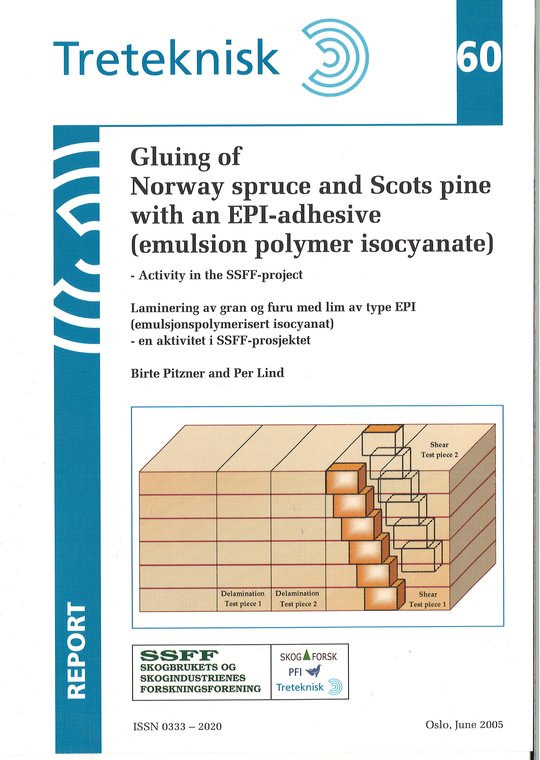60: Gluing of Norway spruce and Scots pine with an EPI-adhesive (emulsion polymer isocyanate)
- Activity in the SSFF-project
Forfattere: Birte Pitzner og Per Lind
Rapport 60, 2005
31 s.
200,- (Gratis for medlemmer)
Last ned
Sammendrag
Del 1: I del 1 ble innflytelsen av lengden på lukket limingstid samt overflateforhold i form av saget og høvlet lamellflate undersøkt.
Granlameller (Norway spruce) ble limt med et godkjent EPI-system fra Dynea ASA, Lillestrøm, Norge. Tester ble utført med hensyn på motstand mot delaminering og bestemmelse av skjærfasthet.
Resultatene fra del 1 konkluderer med at det benyttede limsystemet er sensitivt med hensyn til overholdelse av limprodusentens oppgitte lukkede limingstid. Det samme gjelder for påført limmengde.
Testresultatene vedrørende liming av sagede lamelloverflater er ikke tilfredsstillende.
Samtlige testresultater vedrørende liming av høvlede lamelloverflater der kort lukket limingstid er benyttet, tilfredsstiller alle kravene i EN 386 ”Limtre – Ytelseskrav og minstekrav til produksjon”. Prøvene er testet i henhold til EN 391-Metode C (motstand mot delaminering) og EN 392 (bestemmelse av skjærfasthet).
På forespørsel fra Dynea ASA ble det utført en tilleggstest på delaminasjon med den lengste lukketiden, fordi testresultatene fra den første delamineringstesten ikke var tilfredsstillende. En ny batch av limsystemet ble brukt til å lime høvlede lameller og produsere teststykker lignende de tidligere limte teststykkene. Orienteringen på årringene og dimensjonene var forskjellig fra den første testserien, men den samme testmetoden (EN 391-C) ble benyttet. De nye resultatene oppfylte kravene, i motsetning til de første resultatene.
Del 2: Her ble parametrene lamelltemperatur og trefuktighet og deres innvirkning på limeresultatet studert nøye.
Gran (Norway spruce) og furulameller (Scots pine) ble limt til prøvebjelker ved hjelp av det samme limsystemet som angitt i rapportens del 1. Også her ble prøving utført i henhold til EN 391 (metode B) og EN 392.
Alle prøvestykkene av gran og furu testet i del 2 oppfyller kravene gitt i EN 386 med hensyn til EN 391, metode B og EN 392 for alle kombinasjoner av trefuktighet og temperatur.
Summary
Part 1: In part 1, the influence of the length of the closed assembly time, as well as the surface condition regarding a sawn or planed surface of the lamellae before gluing, was investigated.
Norway spruce lamellae were glued with an EPI-adhesive system from Dynea ASA, Lillestrøm, Norway. Delamination and shear tests were carried out.
The results of part 1 lead to the implication that the used EPI-glue system is very sensitive to the accurate observance of the time limit for the length of the closed assembly time and the amount of glue given by the producer.The outcome of gluing of just sawn and unplaned lamellae is not satisfactory.All test results from the planed lamellae pieces with the short closed assembly time passed the tests and fulfilled all requirements given in EN 386 “Glued laminated timber – Performance requirements and minimum production requirements” of the delamination test (EN 391-C) and shear test (EN 392).
An additional delamination test with the longer closed assembly time was carried out on request by Dynea ASA, because the test results from the first delamination test with the longer closed assembly time were not satisfactory. A new batch of the adhesive system was used to glue planed lamellae and produce test pieces similar to the previously glued test pieces. The annual ring orientation and the dimensions were different to those in the first test series. Afterwards, the same test method (EN 391-C) was applied. The new results passed the requirements, contrary to the first results.
Part 2: In part 2, the influence of the parameters’ temperature and moisture content of the wood on the gluing results were closely investigated.
Norway spruce and Scots pine lamellae were glued into beams with the same glue system from Dynea ASA. Delamination and shear tests were carried out.
All test pieces of Norway spruce and Scots pine tested in part 2 fulfil the requirements given in EN 386 “Glued laminated timber – Performance requirements and minimum production requirements” of the delamination test (EN 391-B) and shear test (EN 392) for all combinations of moisture content and temperature.
